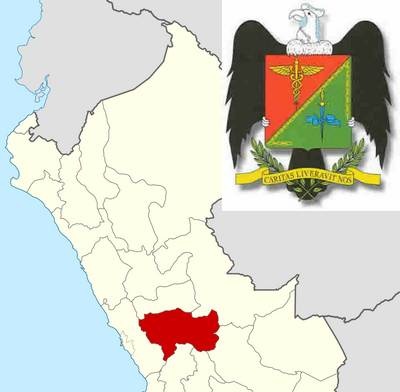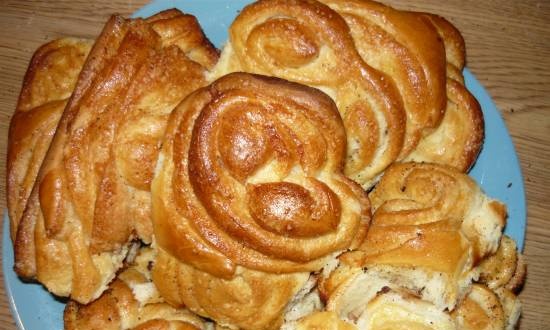|
 The Junin region is one of the central districts of Peru, the territory of which covers the eastern slopes of the Andes and part of the Peruvian Amazon. In the highlands, the climate is dry and cold, and in the jungle it is tropical humid with intense rains, due to which various directions of agriculture are intensively developing. The region produces meat and dairy products, potatoes, corn, legumes, quinoa, coffee, avocados, citrus fruits and other fruits. The Junin region is one of the central districts of Peru, the territory of which covers the eastern slopes of the Andes and part of the Peruvian Amazon. In the highlands, the climate is dry and cold, and in the jungle it is tropical humid with intense rains, due to which various directions of agriculture are intensively developing. The region produces meat and dairy products, potatoes, corn, legumes, quinoa, coffee, avocados, citrus fruits and other fruits.
Junin's cuisine reflects well the mixture of highland and Amazonian gastronomic traits characteristic of the ethnic groups of Quechua and Arawak, with a weak influence of European traditions. The most famous dish is Huancai potatoes (papa a la huancaina) from the city of Huancayo, located at an altitude of more than 3 km above sea level, where, before the conquest of the Incas, there was the kingdom of the Huanca people from the Quechua group. The main activity of the huanca was agriculture and growing potatoes, so it is not surprising that this tuber is used very often.
This dish is easy to prepare and consists of boiled yellow potatoes, laid out on Iceberg lettuce leaves and poured with a semi-liquid sauce of butter, milk, young cheese and yellow hot pepper. When served, the dish is served with boiled egg halves and olives. The Huanca potato has now become a symbol of Peruvian cuisine along with ceviche.
 Junin crosses many rivers, the main ones being Mantaro, Ene, Tambo, Chanchamayo and Satipo. Lakes are rich in fish, so one of the most representative highland products is fried trout (trucha frita)with high nutritional value, tasty and readily available. Before frying, the fish is rolled in breadcrumbs or flour with salt and pepper, due to which it is especially crispy. Serve trout with potatoes, fresh vegetables, herbs, slices of boiled corn, lemon or lime. Junin crosses many rivers, the main ones being Mantaro, Ene, Tambo, Chanchamayo and Satipo. Lakes are rich in fish, so one of the most representative highland products is fried trout (trucha frita)with high nutritional value, tasty and readily available. Before frying, the fish is rolled in breadcrumbs or flour with salt and pepper, due to which it is especially crispy. Serve trout with potatoes, fresh vegetables, herbs, slices of boiled corn, lemon or lime.
Typical dish of the Peruvian highlands, cuy chactadopreparing under the press. To do this, the peeled and washed guinea pig carcass is marinated in lemon juice, and then fried in ground hot red pepper under a stone along with grains of white corn. Often the dish is served with boiled potatoes, rice, salad, boiled eggs. It is noteworthy that in many restaurants the guinea pig is replaced with chicken, to which, in addition to the ingredients of the main recipe, peanuts, onions, garlic and sesame seeds are added.
The region also cooks such an interesting dish with a guinea pig as pachamanca, which is a mixture of several types of meat, stewed in a pit, the walls of which are lined with bricks or stones. At the bottom of the pit, pieces of alpaca, carcasses of guinea pigs and wild duckssometimes replaced by rabbit, beef and pork. Potatoes, sweet potatoes, beans, corn and cassava, seasoned with Peruvian black mint are added to the meat, after which the pit is closed and a fire is made over it.
Patachi - one of the most nutritious and easiest to prepare Junin soups, the ingredients of which are rich in zinc, iron and fiber, necessary for the normal functioning of the body in high mountain conditions. It is cooked in clay pots made from wheat, peas, beans and ground corn with dried llama meat, beef and smoked bacon, leaving to simmer for several hours. When serving, the broth is seasoned with chili and herbs.
In addition to patachi, soups such as chupe de gallina - chicken broth with potatoes and rice, seasoned with parsley, yacu chupe - potato soup with soft cheese and herbs and patashka (patasca) - from grains of white corn with meat.
Name of dish puca picante comes from the Quechua language and means "red". It has the characteristic bright color of red chili, which is abundantly sprinkled with pieces of pork stewed in peanut sauce with garlic and herbs. Puka is typical for rural areas, peasant celebrations on the occasion of the end of joint work in the community and religious holidays. It is usually served with white rice and boiled beetroot pieces.
Elena
|
 The Junin region is one of the central districts of Peru, the territory of which covers the eastern slopes of the Andes and part of the Peruvian Amazon. In the highlands, the climate is dry and cold, and in the jungle it is tropical humid with intense rains, due to which various directions of agriculture are intensively developing. The region produces meat and dairy products, potatoes, corn, legumes, quinoa, coffee, avocados, citrus fruits and other fruits.
The Junin region is one of the central districts of Peru, the territory of which covers the eastern slopes of the Andes and part of the Peruvian Amazon. In the highlands, the climate is dry and cold, and in the jungle it is tropical humid with intense rains, due to which various directions of agriculture are intensively developing. The region produces meat and dairy products, potatoes, corn, legumes, quinoa, coffee, avocados, citrus fruits and other fruits.






